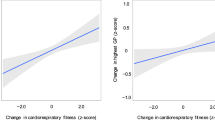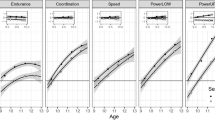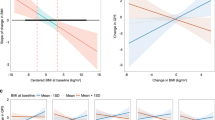Abstract
The present study aimed to analyze the relationship between obesity and different physical fitness markers with academic achievement in adolescents, as well as to check if the “Fat but Fit paradox” is applicable in this context. A total of 188 participants (83 boys) ranging from 12 to 18 years (14.51 ± 1.29 years) underwent a series of fitness tests, and were categorized as “fit” or “unfit” attending to their estimated cardiorespiratory fitness (above or below 42 and 35 ml·kg−1·min−1 for boys and girls, respectively). Participants were also categorized according to their body mass index as having overweight/obesity or not. A variety of fitness markers (i.e., cardiorespiratory fitness, lower-body power, sprint time, and flexibility) were positively associated with academic achievement (all p < 0.05), but no associations were found for upper-body power, upper-limb coordination or agility. Both being fit (β = 0.652, 95% confidence interval: 0.001–1.302) and normoweight (β = 1.085, 0.171–1.999) were positively associated with academic achievement. A higher academic achievement (p = 0.021) was found for fit and normoweight individuals compared to unfit and overweight/obese ones, but no differences were found for the remaining subgroups. These findings suggest that an optimal physical fitness might attenuate the negative consequences induced by obesity on academic achievement.
This is a preview of subscription content, access via your institution
Access options
Subscribe to this journal
Receive 12 print issues and online access
$259.00 per year
only $21.58 per issue
Buy this article
- Purchase on Springer Link
- Instant access to full article PDF
Prices may be subject to local taxes which are calculated during checkout

Similar content being viewed by others
References
Bentham J, Di Cesare M, Bilano V, Bixby H, Zhou B, Stevens GA, et al. Worldwide trends in body-mass index, underweight, overweight, and obesity from 1975 to 2016: a pooled analysis of 2416 population-based measurement studies in 128.9 million children, adolescents, and adults. Lancet. 2017;390:2627–42.
Friedemann C, Heneghan C, Mahtani K, Thompson M, Perera R, Ward AM. Cardiovascular disease risk in healthy children and its association with body mass index: systematic review and meta-analysis. BMJ. 2012;345:1–16.
Clark D, Slate JR, Viglietti GC. Children’s weight and academic performance in elementary school: cause for concern? Anal Soc Issues Public Policy. 2009;9:185–204.
Kamijo Keita, Pontifex MatthewB, O’Leary KevinC, Scudder MarkR, Wu Chien-Ting, Darla M. Castelli and CHH. NIH public access. Natl Institutes Heal. 2011;23:1–7.
Ramaswamy R, Mirochna M, Perlmuter LC. The negative association of BMI with classroom effort in elementary school children. J Child Heal Care. 2010;14:161–9.
Santana CCA, Hill JO, Azevedo LB, Gunnarsdottir T, Prado WL. The association between obesity and academic performance in youth: a systematic review. Obes Rev. 2017;18:1191–9.
Ortega FB, Ruiz JR, Labayen I, Lavie CJ, Blair SN. The fat but fit paradox: what we know and don’t know about it. Br J Sports Med. 2018;52:151–3.
DuBose KD, Eisenmann JC, Donnelly JE Aerobic fitness attenuates the metabolic syndrome score in normal-weight, at-risk-for-overweight, and overweight children. Pediatrics. 2007;120. https://doi.org/10.1542/peds.2007-0443.
Marques A, Santos DA, Hillman CH, Sardinha LB. How does academic achievement relate to cardiorespiratory fitness, self-reported physical activity and objectively reported physical activity: A systematic review in children and adolescents aged 6–18 years. Br J Sports Med. 2018;52:1039.
Alvarez-Bueno C, Hillman CH, Cavero-Redondo I, Sanchez-Lopez M, Pozuelo-Carrascosa DP, Martinez-Vizcaino V. Aerobic fitness and academic achievement: A systematic review and meta-analysis. J Sports Sci. 2020;38:582–9. https://doi.org/10.1080/02640414.2020.1720496.
Muntaner-Mas A, Palou P, Vidal-Conti J, Esteban-Cornejo I. A mediation analysis on the relationship of physical fitness components, obesity, and academic performance in children. J Pediatr. 2018;198:90–7.e4.
García-Hermoso A, Saavedra JM, Olloquequi J, Ramírez-Vélez R. Associations between the duration of active commuting to school and academic achievement in rural Chilean adolescents. Environ Health Prev Med. 2017;22:31.
Adam C, Klissouras V, Ravassolo M, Renson R, Tuxworth W, Kemper H, et al. EUROFIT: European test of physical fitness. Rome: Council of Europe. Committee for the development of sport. 1988;10–70.
Tillaar R Van Den, Marques AMC. A comparison of three training programs with the same workload on overhead throwing velocity with different weighted balls. J Strength Cond Res. 2011;25:2316–21.
Ruiz JR, Ramirez-Lechuga J, Ortega FB, Castro-Piñero J, Benitez JM, Arauzo-Azofra A, et al. Artificial neural network-based equation for estimating VO2max from the 20 m shuttle run test in adolescents. Artif Intell Med. 2008;44:233–45.
Ruiz JR, Cavero-Redondo I, Ortega FB, Welk GJ, Andersen LB, Martinez-Vizcaino V. Cardiorespiratory fitness cut points to avoid cardiovascular disease risk in children and adolescents; what level of fitness should raise a red flag? A systematic review and meta-analysis. Br J Sports Med. 2016, https://doi.org/10.1136/bjsports-2015-095903.
Kuczmarski RJ, Ogden CL, Grummer-Strawn LM, Flegal KM, Guo SS, Wei R, et al. CDC growth charts: United States. Adv Data. 2000;2000:1–27.
Esteban-Cornejo I, Tejero-González CM, Martinez-Gomez D, Del-Campo J, González-Galo A, Padilla-Moledo C, et al. Independent and combined influence of the components of physical fitness on academic performance in youth. J Pediatr. 2014. https://doi.org/10.1016/j.jpeds.2014.04.044.
Cardenas-Sanchez C, Migueles JH, Esteban-Cornejo I, Mora-Gonzalez J, Henriksson P, Rodriguez-Ayllon M, et al. Fitness, physical activity and academic achievement in overweight/obese children. J Sports Sci. 2020;38:731–740.
Santana CCA, Azevedo LB, Cattuzzo MT, Hill JO, Andrade LP, Prado WL. Physical fitness and academic performance in youth: a systematic review. Scand J Med Sci Sport. 2017. https://doi.org/10.1111/sms.12773.
Laurent JS, Watts R, Adise S, Allgaier N, Chaarani B, Garavan H, et al. Associations among body mass index, cortical thickness, and executive function in children. JAMA Pediatr. 2020;174:170–7.
Esteban-Cornejo I, Cadenas-Sanchez C, Contreras-Rodriguez O, Verdejo-Roman J, Mora-Gonzalez J, Migueles JH, et al. A whole brain volumetric approach in overweight/obese children: examining the association with different physical fitness components and academic performance. The ActiveBrains project. Neuroimage. 2017;159:346–54.
Chaddock-Heyman L, Erickson KI, Chappell MA, Johnson CL, Kienzler C, Knecht A, et al. Aerobic fitness is associated with greater hippocampal cerebral blood flow in children. Dev Cogn Neurosci. 2016;20:52–8.
Acknowledgements
The work of Pedro L. Valenzuela is supported by University of Alcalá (FPI2016).
Author information
Authors and Affiliations
Corresponding author
Ethics declarations
Conflict of interest
The authors declare that they have no conflict of interest.
Additional information
Publisher’s note Springer Nature remains neutral with regard to jurisdictional claims in published maps and institutional affiliations.
Rights and permissions
About this article
Cite this article
Martinez-Zamora, M.D., Valenzuela, P.L., Pinto-Escalona, T. et al. The “Fat but Fit” paradox in the academic context: relationship between physical fitness and weight status with adolescents’ academic achievement. Int J Obes 45, 95–98 (2021). https://doi.org/10.1038/s41366-020-00666-5
Received:
Revised:
Accepted:
Published:
Issue Date:
DOI: https://doi.org/10.1038/s41366-020-00666-5



